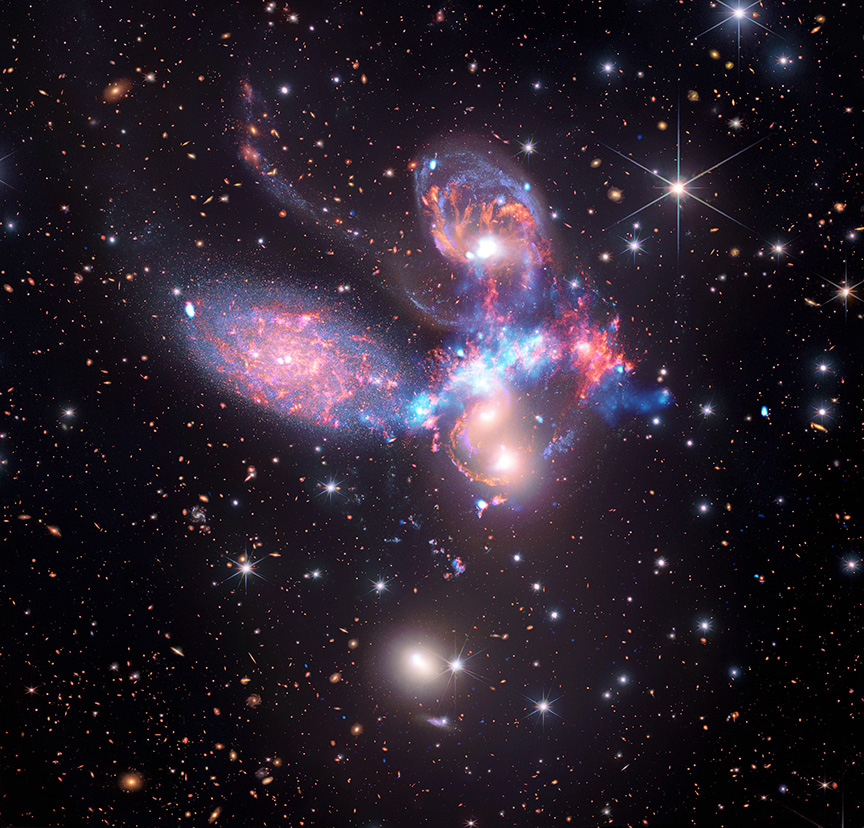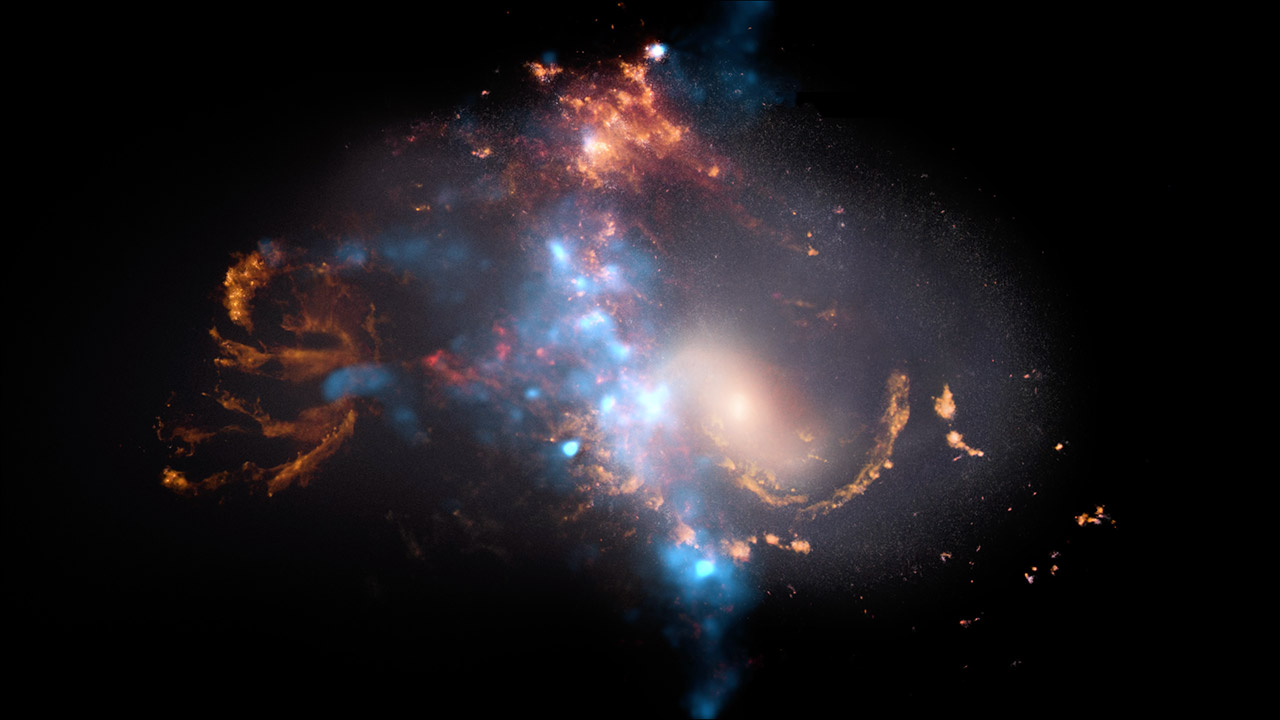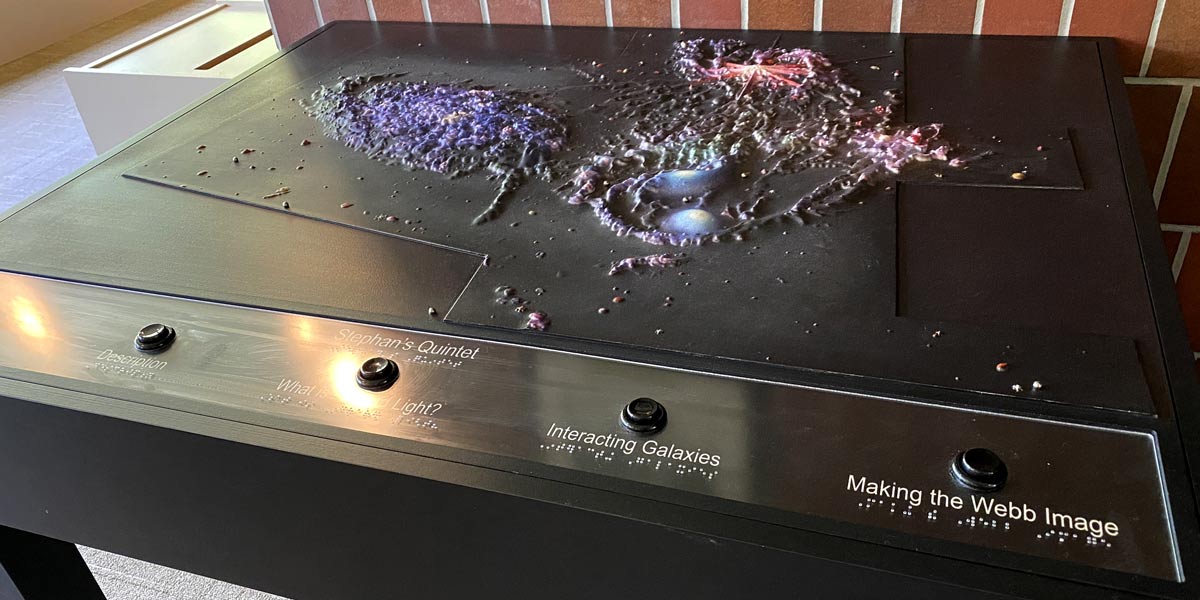Exploring Stephan's Quintet with Multiple Senses

Stephan's Quintet
Credit: X-ray: NASA/CXC/SAO; IR (Spitzer): NASA/JPL-Caltech; IR (Webb): NASA/ESA/CSA/STScI
Summary
Experts created two new visual and auditory experiences to explore the complexity and beauty of a compact galaxy group known as Stephan’s Quintet. The guided three-dimensional visualization surveys the galaxies — their structures, characteristics, and interactions — captured in multiple wavelengths of light by some of NASA’s great observatories. The sonifications scan two-dimensional images of the quintet, translating the data into sound to reveal the depth and richness this intricate environment holds.
Using data gathered by NASA’s Hubble Space Telescope, Spitzer Space Telescope, Chandra X-ray Observatory, and James Webb Space Telescope, astronomers and visualization specialists from across several institutions came together to create two new unique sensory experiences of a compact group of galaxies known as Stephan’s Quintet: a video guiding viewers through a three-dimensional visualization of the galaxies, and audio tracks based on two-dimensional observation images. These add to the previously-developed multi-wavelength images, large tactile/audio display table, and small tactile images, bolstering the overall sensory experience of Stephan’s Quintet.
These resources are the latest among a larger suite of products that enable users to explore the universe through diverse methods. Previous examples include a visualization of Eta Carinae and sonifications of Webb’s first full-color images and spectra. By providing numerous approaches to understanding the data and astronomers’ findings, access to the universe can be widened to members of the public with different learning needs and styles.
“Having this cross-institutional collaboration called NASA’s Universe of Learning enables us to explore these multi-wavelength, multi-format, and multi-sensory experiences for presenting astronomy to the public,” said communications and education lead Gordon Squires of IPAC at Caltech in Pasadena, California. “Being able to see, hear, and touch a distant part of our universe is a rare and wonderful experience.”
Stephan’s Quintet was selected to undergo these interpretation efforts for a multitude of reasons, including the range of existing observations from space-based telescopes (including Webb), and the strong, layered scientific story that can be dissected from this particular galaxy group.
Viewers of the visualization can embark on a guided exploratory tour, and learn how observing different types of light from these galaxies — across the electromagnetic spectrum from infrared to X-rays — can reveal distinctive features of the quintet. The five-minute video delves into each of the five galaxies, the various galaxy types within the group, and the gravitational interactions and relationships between them.
“The visualization team started with the scientific observations from the various telescopes, and then applied some of the same software that Hollywood uses in their feature films to the data,” said visualization scientist Frank Summers of the Space Telescope Science Institute in Baltimore, Maryland, and AstroViz Project Lead for the NASA’s Universe of Learning program. Summers led the team that developed the video. “This combination creates a cinematic learning experience, merging the intellectual and the emotional into one presentation so it has a stronger impact on the audience.”

Viewing Stephan’s Quintet in 3D reveals information not accessible from a 2D point of view, such as the distance between the galaxies and the interactions among them. For example, one galaxy (NGC 7320) is actually much closer to Earth than the others, and another galaxy (NGC 7318B) is undergoing a high-speed collision.
“Shifting from a 2D image to a 3D medium can help viewers really understand the structure of Stephan’s Quintet,” said Summers. “Each observatory that has spent time looking at these five galaxies has enabled us to gather diverse insights and form richer stories about this complex, compact group.”
While exploring Stephan’s Quintet through a 3D visualization can unlock a new visual perspective for viewers, the pixels of the multi-wavelength 2D image have served as a scientific map, paving the way to an audio experience. This process of transferring and representing the data through sound is known as sonification.
“Astronomy has always been very visual, but there’s no reason why we have to represent the data through that manner alone,” said Kimberly Arcand, a visualization scientist at the Chandra X-ray Center in Cambridge, Massachusetts, who leads the development of sonifications for NASA’s Universe of Learning. “This type of depiction is taking the scientific story of Stephan’s Quintet — the deep, dense, and beautiful dataset — and translating it into an auditory experience.”
Each track is paired with the corresponding 2D image of the galaxy group, and users can follow along as the visual is scanned from top to bottom, “releasing” the points of data through sound.

With so many layers, the user has agency in how they listen to the information. The participant can choose to listen to solos of the individual wavelengths gathered by each respective observatory, or hear the full, harmonizing multi-wavelength version. The abundance of instruments in the multi-wavelength sonification track creates a symphony-like experience.
Specific instruments are associated with particular objects: The synthetic glass marimba represents the background galaxies and foreground stars captured by Webb, while the stars with diffraction spikes are represented through crash cymbals. The five main galaxies were assigned smoothly-changing synthetic tones, whereas the X-rays observed by Chandra have a more synthetic string-type of sound.
“When data is translated for another sense, in this case into sound, it creates an opportunity to process that information in a different way,” explained Arcand. “The sonification provides a moment in time to think about where this object is situated in the greater space environment, and can also highlight certain aspects of the data that may not have been noticeable at first glance. Through sound, the listener can get a sense of a super fun dance party: four close interacting galaxies and one sort of introverted galaxy a little further away.”

For Christine Malec, a member of the blind and low vision community who supports this project, the sonifications offer an approachable and visceral way to engage with astronomy. “Sonifications offer a sensory way for me to experience the scale and potency of astronomical phenomena,” said Malec. “They are an invitation to blind and partially-sighted people to listen, enjoy, and then go deeper by reading to understand what exactly is being heard.”
Although two differing modalities, the visualization video and sonifications of Stephan’s Quintet work in complementary ways that ultimately support a deeper understanding and greater appreciation for this wonder in the universe.
These sonifications are the result of a collaborative effort driven by visualization scientist Kimberly Arcand (Chandra), astrophysicist Matt Russo, and musician Andrew Santaguida (both of the SYSTEM Sounds project). Christine Malec consulted as accessibility expert. NASA's Marshall Space Flight Center manages the Chandra program. The Smithsonian Astrophysical Observatory's Chandra X-ray Center controls science from Cambridge Massachusetts and flight operations from Burlington, Massachusetts.
NASA's Universe of Learning is part of the NASA Science Activation program, from the Science Mission Directorate at NASA Headquarters. The Science Activation program connects NASA science experts, real content and experiences, and community leaders in a way that activates minds and promotes deeper understanding of our world and beyond. Using its direct connection to the science and the experts behind the science, NASA's Universe of Learning provides resources and experiences that enable youth, families, and lifelong learners to explore fundamental questions in science, experience how science is done, and discover the universe for themselves.
NASA's Universe of Learning materials are based upon work supported by NASA under cooperative agreement award number NNX16AC65A to the Space Telescope Science Institute, working in partnership with Caltech/IPAC, Center for Astrophysics | Harvard & Smithsonian, and Jet Propulsion Laboratory.
Category:
- Log in to post comments
